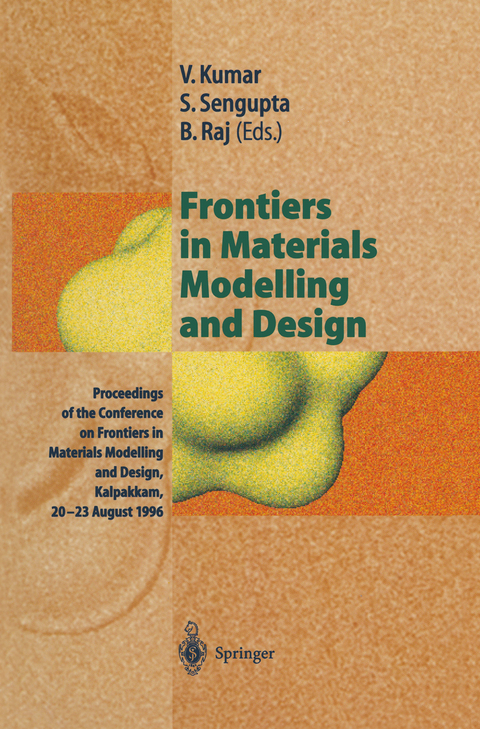
Frontiers in Materials Modelling and Design
Springer Berlin (Verlag)
9783642804809 (ISBN)
The contributions to this volume have been written by leading experts on problems related to developing a fundamental understanding of alloy phase diagrams, intermetallics, defects in semiconductors, surface phenomena, clusters, nanomaterials, phase transitions, and mechanical behaviour of materials, which represent some of the emerging directions in the development and design of novel materials.
I Introduction.- Materials Modelling and Design: An Introduction.- II Methodologies.- Computational Modelling of Atomic-Scale Defect Phenomena in Compound Semiconductors.- The Generalized-Gradient Approximation to Density Functional Theory and Bonding.- Electronic Structure Calculations and Molecular Dynamics Using the Real-Space Method and Optimized Ultra-soft Pseudopotential.- Quantum Simulations Using Linear Scaling Methods: Clusters on Surfaces.- Electronic Structure of Disordered Alloys.- Computer Simulation of Structure and Dynamics in Complex Materials.- III Alloys.- First-Principles Thermodynamics of Alloys.- Electronic Structure of Binary Systems.- First-Principles Phase Stability Study of Metallic Alloys.- First-Principles Approach to Ordering and Clustering Behavior in Metallic Alloys: Application to Al-Li and Ni-Mo Systems.- Thermochemical Modeling of Ternary Alloys from Binary Systems.- Superconductivity in Zr2Rh and its Hydrides: Theory and Experiment.- IV Correlated Electron Systems.- Ab-initio Approach to Electronic Excitation Spectra in Perovskite LaMO3 Oxides.- Theory for the Interdependence of High-Tc Superconductivity and Dynamic Spin Fluctuations.- Electrical Resistivity and Positron Lifetime Studies in the Kondo Insulating System, FeSi1-xGex.- V Clusters and Nanomaterials.- Electronic Structure of Magic Metal Clusters and Cluster Assemblies.- Stability of Molecules and Clusters Studied Through First-Principles Total Energy Calculations.- Adsorption on Clusters.- Ab-initio Molecular Dynamics Study of Impurity in Metal Clusters: NanAl (n = 1-10).- Lyapunov Exponent at the Melting Transition in Small Ni Clusters.- Monte Carlo Studies of Argon Clusters Confined in Zeolites.- Structure-Property Relation in Oxide Nanoparticles.- Nanoparticles of II-VISemiconductors.- Cu Doped ZnO Quantum Dots: Intrinsic and Extrinsic Luminescence.- Carrier Dynamics in Porous and Nanocrystalline Silicon.- Anodisation Time Dependence of Photoluminiscence Properties of Porous Silicon.- Formation of Nanocrystalline Fe-Cu-Nb-Si-B Alloys.- Magnetic Properties of Ultra-fine ?' - Fe4N.- VI Surfaces and Interfaces.- First-Principles Calculation of Surface Step Energies and Interactions.- Deposition of Ga and As Adatoms on the Ge(111) and Si(111) Surfaces: A First-Principles Study.- Steering and Isotope Effects in the Dissociative Adsorbtion of H2/Pd(100).- Growth and Magnetism of Rough Transition Metal Overlayers.- Quantum Adsorbates: Helium in Zeolites.- Effect of High-Energy Heavy-Ion Irradiation on Fe/Tb Multilayers.- VII Phase Transitions.- Isostructural Solid-Solid Transition in Crystalline Systems with Short Ranged Interaction.- Quantum Effects and Phase Transitions in Adsorbed Molecular Layers.- Anchoring Transitions of Nematic Liquid Crystals Induced by Solid Substrate.- Monte Carlo Simulation of the Kinetics of Martensitic-type Restacking Transitions: Dynamic Scaling and Universal Growth Exponents.- Structural Transitions of a Soft Solid: The Skyrmion Lattice.- Electronic Topological Transitions in Elemental Metals and Compounds.- Role of High Pressure in Designing Novel Phases.- Pressure-Induced Polymerisation of Fullerenes.- VIII Microstructure and Deformation.- Microstructural Evolution During Precipitation in Stressed Solids.- Modelling of Process for Controlled Microstructure of Material.- Multiscaling in Normal Grain Growth: A Monte Carlo Study.- Non-destructive Evaluation of Defects: A Model-Based Approach.- Deformation of Nanostructured Materials.- Mechanics of Powder Compaction.- Finite Element Modelling of the CreepBehaviour of Weldments.- List of Authors.
| Erscheint lt. Verlag | 24.11.2011 |
|---|---|
| Zusatzinfo | XIV, 446 p. With 24 Falttafeln. |
| Verlagsort | Berlin |
| Sprache | englisch |
| Maße | 155 x 235 mm |
| Gewicht | 697 g |
| Themenwelt | Naturwissenschaften ► Physik / Astronomie ► Allgemeines / Lexika |
| Naturwissenschaften ► Physik / Astronomie ► Theoretische Physik | |
| Schlagworte | Design • Development • Fullerenes • interfaces • Modeling • Nanomaterial • nanostructure • Potential • Simulation |
| ISBN-13 | 9783642804809 / 9783642804809 |
| Zustand | Neuware |
| Informationen gemäß Produktsicherheitsverordnung (GPSR) | |
| Haben Sie eine Frage zum Produkt? |
aus dem Bereich


